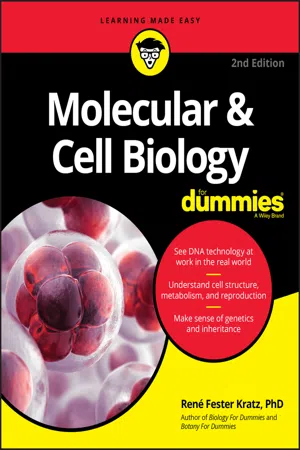
- English
- ePUB (mobile friendly)
- Available on iOS & Android
Molecular & Cell Biology For Dummies
About this book
Your insider guide to the stuff of life
3.8 billion years old and counting, there's more than a little to know about the fundamentals of how life works. This friendly guide takes you from the primordial soup to the present, explaining how specialized cells have given rise to everything living, from the humblest amoeba to walking, talking human beings. Whether you're enrolled in a cell or molecular biology course and need a straightforward overview, or are just curious about the latest advances, this fully updated edition is your all-access ticket to our inner world.
Molecular & Cell Biology For Dummies decodes jargon and theories that can tax even the most devoted student. It covers everything from basic principles to how new technology, genetic testing, and microarray techniques are opening up new possibilities for research and careers. It also includes invaluable tips on how to prepare for—and ace—your exams!
- Explore the structure and function of the cells—and find out why cellular context is crucial to the study of disease
- Discover how molecular biology can solve world problems
- Understand how DNA determines traits and is regulated by cells
- Enhance your knowledge and results with online resources and study tips
From microscopic details to macro concepts, this book has something for you.
Frequently asked questions
- Essential is ideal for learners and professionals who enjoy exploring a wide range of subjects. Access the Essential Library with 800,000+ trusted titles and best-sellers across business, personal growth, and the humanities. Includes unlimited reading time and Standard Read Aloud voice.
- Complete: Perfect for advanced learners and researchers needing full, unrestricted access. Unlock 1.4M+ books across hundreds of subjects, including academic and specialized titles. The Complete Plan also includes advanced features like Premium Read Aloud and Research Assistant.
Please note we cannot support devices running on iOS 13 and Android 7 or earlier. Learn more about using the app.
Information
The World of the Cell
Exploring the World of the Cell



Cells and Viruses: Discovering the Inhabitants of the Microscopic World
You: On the cellular level

Them: Bacteria and viruses
- Bacteria are probably most familiar to you because they can make you sick, but bacteria do many good things, too. The bacteria that live all over your body actually help keep you from getting sick, and many of the foods you eat, such as yogurt, owe their flavors to bacteria.
- Archaea are just as common as bacteria but are usually less familiar to people because they aren’t known for causing human disease, and they’re still being studied by scientists. On a microscope (or with super-powered eyes), archaea look just like bacteria, so scientists didn’t realize archaea existed until around 40 years ago when improvements in molecular biology made their discovery possible.
The Life of a Cell: How Cells Get What They Need to Survive and Reproduce
- When you eat food, you take in a source of energy and matter for your cells that you process with your cellular metabolism (see Chapter 10).
- Your cells do cellular respiration (see Chapter 11), using oxygen to transfer energy out of food into a form that they can use to do work.
- Cells can also use the energy and molecules from food to grow and make new cells (see Chapter 13).
Sexual Reproduction: Shuffling the Genetic Deck for the Next Generation
DNA to Protein: Following the Instructions in the Genetic Code
DNA Technology: Tackling the World’s Problems
Table of contents
- Cover
- Table of Contents
- Introduction
- Part 1: The World of the Cell
- Part 2: Molecules: The Stuff of Life
- Part 3: The Working Cell
- Part 4: Genetics: From One Generation to the Next
- Part 5: Molecular Genetics: How Cells Read the Book of Life
- Part 6: Molecular Biology: Harnessing the Power of DNA
- Part 7: The Part of Tens
- Index
- About the Author
- Connect with Dummies
- End User License Agreement
